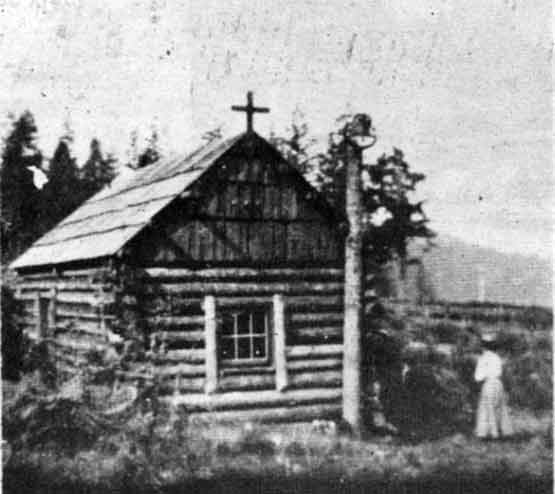
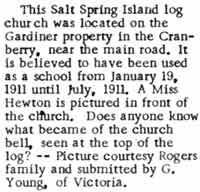 Photo of the building, possibly before it was used as a schoolhouse (but equally possible while it was used as both schoolhouse and for church and community gatherings)
Photo of the building, possibly before it was used as a schoolhouse (but equally possible while it was used as both schoolhouse and for church and community gatherings)
The piece of land is far smaller than the surrounding properties, so was presumably eventually donated (or sold for a nominal fee) to create a boundary for the Cranberry Marsh Schoolhouse.
December 10th 1908 it was agreed between the then owner Charlie Gardner and the redoubtable Reverend Wilson, to rent his “shack” for $10 a year for a church for the recent settlers in the Cranberry Marsh. A bee was held to fix it up. Rev. Wilson Our Life on Salt Spring Island
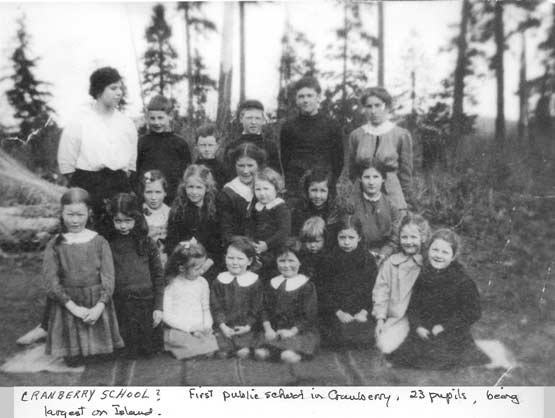
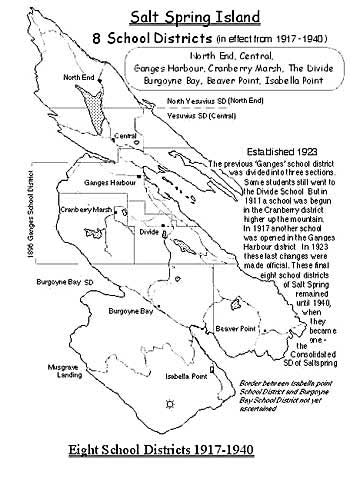
“In 1903 the Cranberry Road was made, and families began to settle in the area called Cranberry Marsh on the slopes where Mount Maxwell begins to rise to form Baynes Peak [A cranberry marsh in this area was drained before 1900]. They were mostly British and American, but needed free schooling. The Ganges parents thought of them as the ‘rougher element’. By 1910 there were enough children to have a school of their own — until then, the children had walked down the mountain to the Divide School.”
Usha Rautenbach — Early Schools Of Salt Spring Island
[My map, made in earlier days of digitisation I'm afraid — yes, I do need to redo it]
From August 1911 the small log building served as the Cranberry Marsh Schoolhouse; church services continued to be held there, and it would also have served as the local community's “hall” for meetings, celebrations, etc. It was not continuously used for school (due to fluctuations in enrolment — when there were too few in the Cranberry area the government did not send a teacher, so the remaining students used to walk on down to the Divide Schoolhouse on Blackburn Road; similarly, when the enrolment in the Divide School District dropped too low the Divide students would walk up to the Cranberry Marsh Schoolhouse; when enrolment was sufficient for the government to provide two schoolteachers both schools ran at the same time).

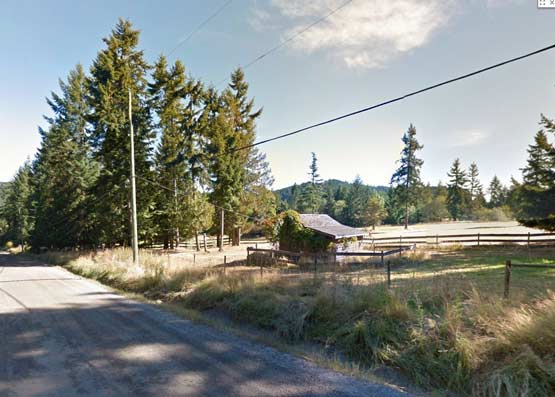
Cranberry Marsh School was opened in 1911 with teacher G.F.Harris and Trustees E.J. Seymour, J.Rogers and T. Clark. The school was in continuous operation from 1911-24, closed from 1924-6, then re-opened briefly for the 1927-1928 school year, but in April 1928 “Cranberry Marsh School closed — too few children” as the Sidney Review put it; after which it has been assumed by researchers that the pupils went to the Divide School until 1940 (when the students of both areas were obliged to attend the Consolidated School in Ganges at the present-day Salt Spring Elementary School building). Nevertheless, Jessie Nobbs was the May Queen for Cranberry Marsh in 1930, possibly representing her community rather than her community's school, although all the other May Queens were representing their school.
Mort Stratton’s History of Farming on Salt Spring says of the Great Depression that “Voters Lists for the 30s indicate that the number of farmers in the Ganges area dropped from 91 in 1933 to 72 in 1937, with similar drops elsewhere” so that the Cranberry farms became deserted.
If you have specific questions not answered by the above, feel free to ask.
And if anyone finds the URL for the school photograph of 8 students of the Cranberry School, do let me know — it belongs with audio 112
Any audio of Ted Brown has lots of snippets about the Cranberry, where he lived.
I did a transcription of tape 112, in the course of which I figured out much of what I finally worked out to be the Story of Cranberry School and it Community
Usha Rautenbach
volunteer researcher for the SSIA